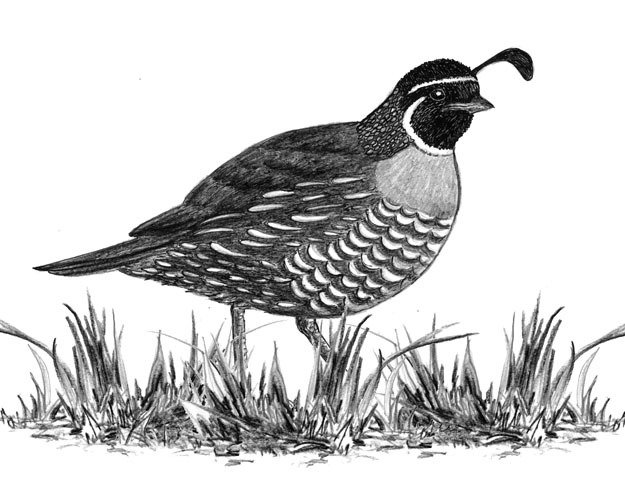
Dear Bird Folks,
I just came back from a trip to California and fell in love with their adorable quail. They reminded me of the bobwhites we used to see around here. But unlike our bobwhites, these quail have weird plumes sticking out of the tops of their heads. What is the reason for those plumes and do we ever see California Quail around here?
– Phil, Sandwich, MA.
No, we don’t, Phil,
We don’t see California Quail around here. At first I was going to give you the “Duh!” treatment because the word “California” in their name should tell you that those birds aren’t found in these parts. But sometimes common names can be misleading. For example, the Cape has nesting “Carolina” Wrens, “Virginia” Rails and “Arctic” Terns and we are a long way from any of those places. But with the exception of a few adjoining Western states, California Quail really are California birds. As for the weird head plume, the bird is from California. Everything is weird out there. Duh!
Our fondness for bobwhites aside, the California quail, with its head plume (which is actually made of several individual feathers), really is the prototypical quail. Tell someone to draw a quail and the head plume will be the first thing they’ll draw. Even the logo of TV’s Partridge Family (a colorful cartoon image of an adult partridge followed by five little ones) had a plume. This is odd since partridges typically don’t have plumes. The plume is really a quail thing. But there was no way liberal Hollywood was ever going to produce a TV show called “The Quail Family,” no matter how it was spelled.
I think most Cape Codders remember the old days when dozens of pudgy bobwhites would suddenly appear under our bird feeders on a cold winter’s day. It’s sad to think that those days may be over, but such is not the case in California. Despite the ridiculous human population growth and urban sprawl of the last century, the California Quail continues to hold on. With the ability to endure extreme heat and dry conditions, this quail is perfectly designed to live in California and has been rightly named its state bird. When conditions are dry the birds obtain much of their water from ingesting moist seeds and plants; however, the more affluent birds purchase bottled water.
Like all quail, the California Quail spends most of its life on the ground, searching for food. Because it’s a weak flyer, the bird will usually freeze or run for cover if threatened. While it can fly well enough to escape a hungry coyote or bobcat, its flight skills are no match for, say, a speedy Cooper’s Hawk. When protecting their young, adults will fake an injury and occasionally the male will even attack the predator. But it’s doubtful these attacks are very effective. I mean how scary can a bird be when it has that silly plume sticking out of the top of its head? So why do the birds have that decorative plume in the first place? To attract a mate, of course. Isn’t that always the reason? Apparently, the ladies are attracted to the males with the biggest and best looking plumes (talk about being superficial). According to a University of California study, a few males were fitted with plume “extensions.” (Only in California could someone find a source of plume extensions). The enhanced males did indeed garner more attention from the females. Note: Males with lesser plumes shouldn’t be discouraged. Sometimes birds that even look bald do okay…just ask the eagle.
As is the case with most quail, these birds build their nests on the ground. The female does most of the incubating, but her mate is always around, keeping an eye out for danger. Since the parents provide no food for their babies, the little ones must start searching for food a few hours after hatching. However, there is one odd thing that the parents do provide. Inside the quails’ intestines are protozoans that help digest the vegetation they eat. The babies obtain these protozoans by pecking at the adults’ feces. (And you thought it was bad when your parents made you eat broccoli.)
California Quail are sociable birds, so eventually several families join together and become a large flock (aka, covey). A covey can be quite impressive in size, with the numbers ranging from a few dozen birds to several hundred. And even though the California Quail population isn’t what it used to be, they seem to be adapting to human encroachment and in many ways have acclimated to changes we’ve made to the landscape. In recent years they have taken advantage of waste grain produced by farms and seeds dropped from bird feeders. (Bless those bird feeders.)
You aren’t the only one who is enamored with the California Quail, Phil. They have been introduced to Hawaii, Argentina, Europe and to faraway New Zealand, where they compete with kiwis and sheep for the locals’ attention. But California and its surrounding states are where this bird belongs. Hopefully, with adequate protection and proper conservation measures, these handsome birds will continue to thrive and entertain folks for years to come, and won’t become the bobwhites of the West (sniff).